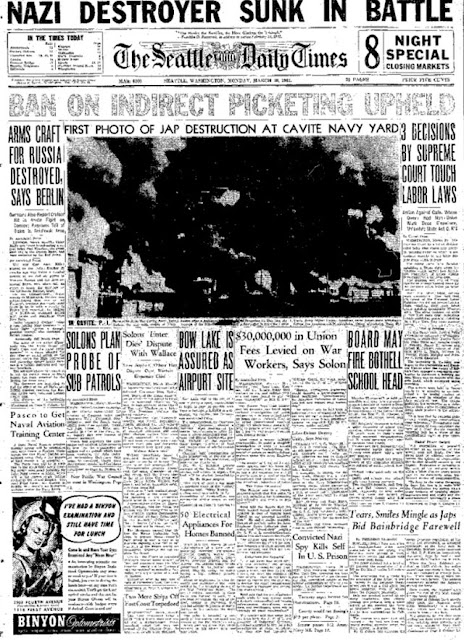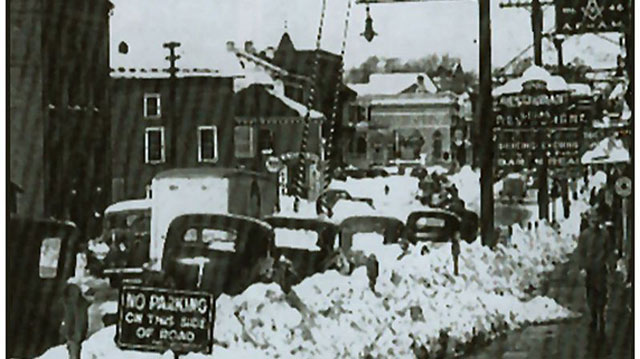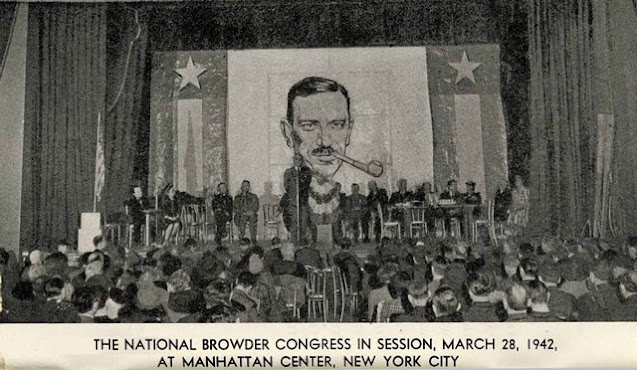Tuesday 31 March 1942
 |
| "Victorious Japanese troops cluster around a coastal defence 6-inch gun and shout 'Banzai' in celebration after the conquest of Christmas Island, off the southern coast Java, 31 March-1 April 1942. The island was taken without a fight, after Indian troops defected in support of the Japanese." © IWM HU 2782. |
Battle of the Pacific: Japanese bombers raid Christmas Island, a British possession south of Java, at dawn on 31 March 1942. Then, a small Japanese invasion force approaches the island. Timing things to perfection, a group of Punjab soldiers in British service then mutinies, killing the island's commander, Captain L.W. Williams, and four British NCOs. The mutineers signal the Japanese that the coast is clear, and about 900 soldiers land without opposition, beginning a Japanese occupation of Christmas Island that turns out to be not very useful for them. Aside from its prime geographical location, Christmas Island contains rich phosphate deposits that the Japanese are happy to exploit, but Allied domination of the surrounding seas eventually halts that. The events on Christmas Island form another instance of Indian soldiers abandoning the British and going over the enemy, such as in Singapore, perhaps in response to Japanese propaganda about a free India.
 |
| This cartoon by Leslie Gilbert Illingworth (1902-1979) appeared in the 31 March 1942 Daily Mail. It shows three hunters, riding on elephants marked "Congress," "Moslems," and "Princes" stalking a tiger marked "Indian Disunity." Sir Stafford Cripps, on a mission to create some kind of agreement with Indian nationalists, shouts, "Now's your chance." Indian turmoil already is affecting the war effort directly, such as by today's mutiny by Indian troops on Christmas Island that turns the island over to the invading Japanese. (National Library of Wales). |
The Chinese 200th Division and 22nd Division, having made contact northeast of Toungoo, withdraw north of Pyinmana to rest and recuperate after the fierce battles at Toungoo. Only a small Chinese rear guard is left on the road east from Toungoo to Mawchi, and the Japanese at Toungoo quickly overpower them and head toward Bawlake.
US Navy submarine USS Seawolf spots Japanese cruiser Naga supporting the landings on Christmas Island and fires four torpedoes. They all miss and the crew of the Naga apparently does not see them. The Seawolf remains in the area and prepares to attack the cruiser again on 1 April.
The Japanese Indian Ocean raid (Operation C) by the Kido Butai task force that bombed Pearl Harbor officially begins today. Admiral Chūichi Nagumo sailed from Staring Bay, Celebes Islands, on 26 March 1942. Royal Navy Vice-Admiral Sir James Somerville has sailed out with aircraft carriers HMS Formidable, Hermes, and Indomitable to block Nagumo. The Japanese already have occupied the Andaman Islands and their main objective is to destroy the British Eastern Fleet at Ceylon. So, if Somerville risks his entire fleet, in a sense he is playing into Japanese hands.
The Japanese Indian Ocean raid (Operation C) by the Kido Butai task force that bombed Pearl Harbor officially begins today. Admiral Chūichi Nagumo sailed from Staring Bay, Celebes Islands, on 26 March 1942. Royal Navy Vice-Admiral Sir James Somerville has sailed out with aircraft carriers HMS Formidable, Hermes, and Indomitable to block Nagumo. The Japanese already have occupied the Andaman Islands and their main objective is to destroy the British Eastern Fleet at Ceylon. So, if Somerville risks his entire fleet, in a sense he is playing into Japanese hands.
 |
| The New Castle (Pennsylvania) News optimistically reports that the Allies control the airspace around Australia. |
Eastern Front: The Battle of Suursaari continues without much action today. The Soviet troops holding Bolshoy Tyuters abandon the island across the frozen ice of the Gulf of Finland sometime during the day or night. Finnish troops prepare to attack the island on 1 April 1942.
The Luftwaffe is increasingly active from bases on the Crimea, and they are operating out to sea as well as over the two battles (at Sevastopol and the Parpach Narrows) that are more or less in progress. They sink Soviet submarine Shch-210 of the Black Sea Fleet off Shabler Cape sometime during March. There is no record of any survivors.
European Air Operations: A lull in RAF Bomber Command operations following the recent heavy raids on Lubeck, Essen, and St. Nazaire continues today. During the day, 11 Hampdens and 6 Wellington bombers fly over Germany looking for targets of opportunity. Six bombers find something useful to bomb with no losses.
After dark, four bombers manned by picked crews (presumably because the German defenses will be heavy following the recent raids, and the crews are using Gee for guidance) fly to Essen. However, the night is overcast and the bombers only bomb random targets (one plane bombs Essen, another Hamborn), with no losses.
The Luftwaffe, taking to heart Adolf Hitler's order that it punish the British for its highly destructive raid on Lubeck, raids Brixham and sinks 3711-ton British freighter SS London City.
 |
| US Navy patrol gunboat USS Niagara (PG-52) entering Pearl Harbor on 31 March 1942 (US Navy Bureau of Ships photo 19-N-29806). |
Battle of the Atlantic: After many days of murderous German attacks by air and sea, British Convoy PQ-13 arrives at Murmansk (some ships continue sailing on to Archangel). The Luftwaffe, using its dominance of the skies over Soviet territory, continues the attacks against the ships in the port. Five ships out of the original fifteen have been lost, and four more will be lost in port. Two more will be lost on the return trip, Convoy QP 10.
U-754 (Kptlt. Hans Oestermann), on its second patrol out of Brest, continues a very successful patrol off the East Coast of the United States with a victory about 53 miles northeast of Virginia Beach against a tug and the three barges it is towing:
- 441-ton tug Menominee (sunk)
- 490-ton Ontario (damaged)
- 914-ton Barnegat (sunk)
- 914-ton Allegheny (sunk)
The barge Ontario has dunnage cargo and remains afloat, providing a huge liferaft for the men on the nine men manning the barges and two of the 18 men from the tug.
 |
| British tanker San Gerardo, sunk by U-71 on 31 March 1942. |
U-71 (Kptlt. Walter Flachsenberg), on its fifth patrol out of St. Nazaire, torpedoes and sinks 12,915-ton British tanker San Gerardo southeast of New York City. Like virtually all traffic off the East Coast of the United States, San Gerardo is an independent. There are 51 deaths and six survivors. The ship takes 17,000 tons of fuel oil to the bottom with it.
Italian submarine Pietro Calvi torpedoes and shells 7451-ton US tanker SS T.C. McCobb off Surinam. There are two deaths during the sinking and another two men later perish from exposure.
U-702 (Kptlt. Wolf-Rüdiger von Rabenau), on its first patrol out of Helgoland, disappears without a trace somewhere south of Norway. It hits a mine on or about this date in the British field FD-37 that had been laid by Free French submarine Rubis on 21 March 1942. All 44 men on board perish. U-702 ends its career with no victories.
 |
| Submarine depot ship HMS Adamant at sea in the Atlantic guarding a convoy. "Two ships of the convoy shelter under the 4.5" guns of HMS ADAMANT." © IWM A 8433. |
Battle of the Mediterranean: Royal Navy submarine Proteus torpedoes and sinks 3567-ton Italian transport Bosforo 24 miles off Sapienza. Total casualties are unknown, but apparently, there was a heavy loss of life. This is the second and last victory by Proteus on this patrol.
Axis air attacks on Malta remain heavy, with 20 alerts in the last 24 hours. Fortunately for the inhabitants of the island, there are low-lying clouds and this affects bombing accuracy. While 17 bombers attack during the day, only three manage to drop their bombs on land. Luftwaffe Bf 109s are active over the island and shoot down a Mosquito of RAF No. 69 Squadron right after it takes off from Luqa airfield.
Anglo/Indian Relations: The Indian Congress Party rejects the British offer of Dominion status after the war and demands immediate independence.
Anglo/Indian Relations: The Indian Congress Party rejects the British offer of Dominion status after the war and demands immediate independence.
US Military: Major General (temporary) Carl Spaatz, commander of the Air Force Combat Command, suggests that the US Army Eighth Air Force be sent to the United Kingdom for operations over the Continent. In May 1942, Spaatz will become its commander and oversee the bombing campaign against the Reich.
The US 5th Air Force adds to the growing reinforcement of Port Moresby by transferring the 8th Bombardment Squadron (Light) to there from Charters Towers, Queensland, Australia.
New Zealand Military: Records indicate that as of the end of March 1942, New Zealand has 61,368 servicemen overseas (mostly in the Middle East) with 52,712 of them in the Army. The New Zealand Home Guard has a ration strength of 100,000.
American Homefront: The San Francisco News reports today that "The FBI today was rounding up known and suspected members of the toughest alien Japanese group in San Francisco." This group, the newspaper reported, "was a 'front' for the ruthless and dread Black Dragon Society, the most nationalistic and terroristic of all Japanese secret bodies." The group operated gambling parlors where the "real" purpose, according to the Northern California FBI chief, Nat J.L. Pieper, was:
to inform the Japanese people of their national heritage and rights to dominate the world, and to conceive a counter-movement to rectify any and all projects detrimental to Japan.
Several of these gamblers were arrested along with a Japanese movie distributor "who was said to have admitted he had paid dues to the secret group."
March 1942
March 1, 1942: Second Battle of Java Sea
March 2, 1942: Huge Allied Shipping Losses at Java
March 3, 1942: Japan Raids Western Australia
March 4, 1942: Second Raid On Hawaii
March 5, 1942: Japan Takes Batavia
March 6, 1942: Churchill Assaults Free Speech
March 7, 1942: British Defeat in Burma
March 8, 1942: Rangoon Falls to Japan
March 9, 1942: Japanese Conquest of Dutch East Indies
March 10, 1942:US Navy attacks Japanese Landings at Lae
March 11, 1942: Warren Buffett's First Stock Trade
March 12, 1942: Japan Takes Java
March 13, 1942: Soviets Attack In Crimea Again
March 14, 1942: The US Leans Toward Europe
March 15, 1942: Operation Raubtier Begins
March 16, 1942: General MacArthur Gets His Ride
March 17, 1942: MacArthur Arrives in Australia
March 18, 1942: Japan Attacks In Burma
March 19, 1942: Soviets Encircled on the Volkhov
March 20, 1942: "I Shall Return," Says MacArthur
March 21, 1942: Germans Attack Toward Demyansk
March 22, 1942: Second Battle of Sirte
March 23, 1942: Hitler's Insecurity Builds
March 24, 1942: Bataan Bombarded
March 25, 1942: Chinese Under Pressure in Burma
March 26, 1942: Win Or Die, Vows MacArthur
March 27, 1942: The Battle of Suusari
March 28, 1942: The St. Nazaire Commando Raid
March 29, 1942: The Free Republic of Nias
March 30, 1942: Japanese-Americans Off Bainbridge Island
March 31, 1942: Japanese Seize Christmas Island
April 1942
April 1, 1942: Convoys Come to the USAApril 2, 1942: Doolittle Raiders Leave Port
April 3, 1942: Japanese Attack in Bataan
April 4, 1942: Luftwaffe Attacks Kronstadt
April 5, 1942: Japanese Easter Sunday Raid on Ceylon
April 6, 1942: Japanese Devastation In Bay of Bengal
April 7, 1942: Valletta, Malta, Destroyed
April 8, 1942: US Bataan Defenses Collapse
April 9, 1942: US Defeat in Bataan
April 10, 1942: The Bataan Death March
April 11, 1942: The Sea War Heats Up
April 12, 1942: Essen Raids Conclude Dismally
April 13, 1942: Convoy QP-10 Destruction
April 14, 1942: Demyansk Breakout Attempt
April 15, 1942: Sobibor Extermination Camp Opens
April 16, 1942: Oil Field Ablaze in Burma
April 17, 1942: The Disastrous Augsburg Raid
April 18, 1942: The Doolittle Raid bombs Japan
April 19, 1942: British in Burma Escape
April 20, 1942: The Operation Calendar Disaster
April 21, 1942: Germans Relieve Demyansk
2021


























